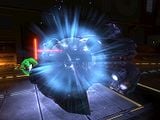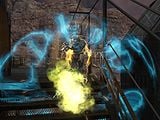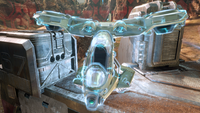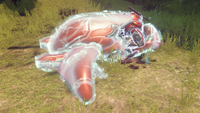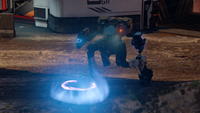Electromagnetic pulse: Difference between revisions
From Halopedia, the Halo wiki
Tag: Mobile edit |
|||
| Line 21: | Line 21: | ||
*During the [[Carrow Conflict]], Governor [[Ellis Gass]] and her engineers created a makeshift EMP canon using the core of a [[HAVOK tactical nuclear weapon]] and an [[M68 Gauss cannon]] to [[Battle of the Sharquoi Hive|use]] against [[Jiralhanae Chieftain]] [[Hekabe]] and the ''[[vertex]]'', the [[Forerunner]] device that allowed him to control the [[Sharquoi]]. The EMP temporarily knocked out all of the Forerunner technology in the Sharquoi hive, although it quickly rebooted. This allowed Ellis time to remove the ''vertex'' from Hekabe and end his control over the Sharquoi.{{Ref/Novel|Env}} | *During the [[Carrow Conflict]], Governor [[Ellis Gass]] and her engineers created a makeshift EMP canon using the core of a [[HAVOK tactical nuclear weapon]] and an [[M68 Gauss cannon]] to [[Battle of the Sharquoi Hive|use]] against [[Jiralhanae Chieftain]] [[Hekabe]] and the ''[[vertex]]'', the [[Forerunner]] device that allowed him to control the [[Sharquoi]]. The EMP temporarily knocked out all of the Forerunner technology in the Sharquoi hive, although it quickly rebooted. This allowed Ellis time to remove the ''vertex'' from Hekabe and end his control over the Sharquoi.{{Ref/Novel|Env}} | ||
*The [[Guardian]]s are equipped with a technology similar to an EMP, called [[attenuation pulse emitter]]s, which can disable every piece of technology on a planet and surrounding space to keep "troublesome worlds" in-line<ref>'''[[Halo 5: Guardians]]''', campaign level, ''[[Guardians]]''</ref> by instantaneously neutralizing local power networks through a series of debilitating pulses.<ref name="wf">''[[Halo: Warfleet]]'', p. 88-89</ref> However, with enough time, the damage can be repaired, particularly by [[Huragok]]s.{{Ref/Novel|LoO}}{{Ref/Novel|BadB}} | *The [[Guardian]]s are equipped with a technology similar to an EMP, called [[attenuation pulse emitter]]s, which can disable every piece of technology on a planet and surrounding space to keep "troublesome worlds" in-line<ref>'''[[Halo 5: Guardians]]''', campaign level, ''[[Guardians]]''</ref> by instantaneously neutralizing local power networks through a series of debilitating pulses.<ref name="wf">''[[Halo: Warfleet]]'', p. 88-89</ref> However, with enough time, the damage can be repaired, particularly by [[Huragok]]s.{{Ref/Novel|LoO}}{{Ref/Novel|BadB}} | ||
*By [[2559#October|October 2559]], the {{UNSCShip|Infinity}}'s [[Broadsword]] fighters are equipped with Shield Busting [[ASGM-15]] EMP-assisted missiles which use an initial burst of electromagnetic energy to penetrate an energy shield before delivering a hull-penetrating charge.{{Ref/Novel|SoR|Chapter=19}} | |||
*On [[2559#October|October 14, 2559]], during the [[Battle of Epsilon Clarion]], the ''Spirit of Fire'' bombarded [[Epsilon Clarion]] with EMP MAC rounds which took down the facility's shields, fried all electronics in the area and reduced Epsilon Clarion into a pool of molten lava. The power of the EMP rounds was enough to cause damage to the facility's systems even before the shield came down and to wipe out the code of the powerful Forerunner [[archeon-class ancilla]] [[Intrepid Eye]], finally destroying her.{{Ref/Novel|DW}} | *On [[2559#October|October 14, 2559]], during the [[Battle of Epsilon Clarion]], the ''Spirit of Fire'' bombarded [[Epsilon Clarion]] with EMP MAC rounds which took down the facility's shields, fried all electronics in the area and reduced Epsilon Clarion into a pool of molten lava. The power of the EMP rounds was enough to cause damage to the facility's systems even before the shield came down and to wipe out the code of the powerful Forerunner [[archeon-class ancilla]] [[Intrepid Eye]], finally destroying her.{{Ref/Novel|DW}} | ||
Revision as of 21:49, December 12, 2021
| There is more information available on this subject at Electromagnetic pulse on the English Wikipedia. |

An electromagnetic pulse (EMP) is the electromagnetic radiation from an explosion (especially a nuclear explosion) or an intensely fluctuating magnetic field caused by Compton-recoil electrons and photoelectrons from photons scattered in the materials of the electronic or explosive device or in a surrounding medium. While organic tissue is unaffected, the resulting electric and magnetic fields may couple with electrical/electronic systems to produce damaging current and voltage surges. The effects are usually not noticeable beyond the blast radius unless the device is nuclear or specifically designed to produce an electromagnetic shockwave. An alternate definition is: a broadband, high-intensity, short-duration burst of electromagnetic energy.
The worst of an electromagnetic pulse generally only lasts for a second, but any unprotected electrical equipment will be affected by the pulse.[1]
Notable examples
There have been several noteworthy instances in which an EMP has appeared.
- The detonation of a nuclear weapon, such as a Shiva-class nuclear missile, is almost always followed by a massive electromagnetic pulse.[2]
- During the Battle of the Etran Harborage, the smart-AI Serina had Sergeant John Forge use the EMP weapon of several Gremlins to attack the Forerunner pylons attempting to pull the UNSC Spirit of Fire into the shield world known as the Etran Harborage. As a result, the Spirit of Fire had time to effect a rescue of Alpha, Bravo and Charlie Platoons.[3]
- During the Battle of the Rubble, SPARTAN-II Grey Team used a small EMP device to fry the systems on an Insurrectionist freighter called the Kestrel. This was to wipe its navigation database in accordance with the Cole Protocol which they were at the Rubble enforcing.[4]
- In the aftermath of Operation: UPPER CUT, both SPARTAN-B312 and the satellite Navigation Beacon RA-15 witnessed a purple-tinted EMP cloud emanate from the wreckage of the Covenant CSO-class supercarrier Long Night of Solace after the improvised slipspace bomb was activated. The cloud disabled all electronics within its vicinity, including the NAV Beacon.[5]
- During the Battle of Installation 04, Cortana diverted John-117's energy shields into an EMP to disable Halo's phase pulse generators.[6]
- The deep-space artifact let out an enormous electromagnetic pulse that briefly canceled out all communications in the Sol system. It later let out another pulse upon deactivation.
- During the Skirmish over Threshold, John-117 used the EMP emitted by a plasma grenade to disable the electronics of a locked door on Ascendant Justice, which allowed him to open the door.[7]
- The in-atmosphere jumping of the Solemn Penance to slipspace above New Mombasa created a massive electromagnetic pulse that damaged electrical systems in the city, and fried the navigational and safety systems of nearly five dozen SOEIV pods unfortunate enough to drop towards the carrier at that exact moment, plunging them and the Orbital Drop Shock Troopers inside free-falling to near-certain death.[8]
- The UNSC Port Stanley was equipped with an EMP cannon, for disabling ships not hardened against it, which it used against the Hudal-class auxiliary vessel Piety.[9]
- While trying to stop the Didact, Cortana again modified the Master Chief's shields to give off an EMP to disable a carrier wave generator. She referred to it as "taking a page out of our old playbook."[10]
- During the Carrow Conflict, Governor Ellis Gass and her engineers created a makeshift EMP canon using the core of a HAVOK tactical nuclear weapon and an M68 Gauss cannon to use against Jiralhanae Chieftain Hekabe and the vertex, the Forerunner device that allowed him to control the Sharquoi. The EMP temporarily knocked out all of the Forerunner technology in the Sharquoi hive, although it quickly rebooted. This allowed Ellis time to remove the vertex from Hekabe and end his control over the Sharquoi.[11]
- The Guardians are equipped with a technology similar to an EMP, called attenuation pulse emitters, which can disable every piece of technology on a planet and surrounding space to keep "troublesome worlds" in-line[12] by instantaneously neutralizing local power networks through a series of debilitating pulses.[13] However, with enough time, the damage can be repaired, particularly by Huragoks.[14][15]
- By October 2559, the UNSC Infinity's Broadsword fighters are equipped with Shield Busting ASGM-15 EMP-assisted missiles which use an initial burst of electromagnetic energy to penetrate an energy shield before delivering a hull-penetrating charge.[16]
- On October 14, 2559, during the Battle of Epsilon Clarion, the Spirit of Fire bombarded Epsilon Clarion with EMP MAC rounds which took down the facility's shields, fried all electronics in the area and reduced Epsilon Clarion into a pool of molten lava. The power of the EMP rounds was enough to cause damage to the facility's systems even before the shield came down and to wipe out the code of the powerful Forerunner archeon-class ancilla Intrepid Eye, finally destroying her.[17]
Gameplay
EMP is also an in-game effect in the Halo games, that disables energy shields and vehicles. It is produced by certain weapons and equipment.
- In Halo 2, the Sentinels sometimes emit an EMP when destroyed. This effect disables shields, but vehicles are unaffected.
- In Halo 3, the power drain uses EMP to disable shields, vehicles and other power sources.
- The overcharged blast from a Type-25 and Type-54 plasma pistol will temporarily disable vehicles and energy shields.
- In Halo Wars, Professor Anders' vehicle, the Gremlin, uses an EMP cannon as its main armament to disable enemy ground vehicles. It is vital in the level Shield World, temporarily disabling Forerunner pylons to buy the player time to complete their mission.
- In Halo Wars, the Vampire's stasis cannon uses EMP as well to drain power from enemy aircraft.
- In Halo: Reach, armor lock can trigger an EMP after use, which can take out a Spartan's shields. Combined with a quick and accurate melee, this can result in an almost instant kill.
- In Halo: Reach the M319 grenade launcher has a secondary function that acts like an EMP. It awards a player an EMP Blast Medal when it kills an enemy, being the only other weapon in the game that awards the medal.
- In Halo 2: Anniversary the bases on the map Bloodline have consoles that allow players to activate an EMP around the area. This can be made in a Forge map too.
- In Halo 5: Guardians the Echidna can EMP targets.
- In Halo 5: Guardians Hannibal Mantis can EMP targets with its stomp attack.
- In Halo Wars 2 Spirit of Fire's MAC has been upgraded with EMP capabilities to disable Sentinel defenses at the Forerunner Conduits near the Cartographer and also outside of the Map Room itself. The EMP is the only in-game weapon that can defeat the Sentinel Swarms and was created by Professor Ellen Anders and Isabel. In-game this is referred to as the EMP MAC. After initially being fired under Isabel's control, it becomes a Leader power for its subsequent uses.
- In Halo: Spartan Assault, an EMP Blast stuns all ally and enemy units around the EMP radius.
- In Halo: Spartan Strike, throwing an EMP Grenade will cause the enemies to be stunned, rendering them unable to attack or move temporarily.
- In Halo Infinite, overcharged blasts from Plasma Pistols will no longer EMP vehicles. Instead, this function has been given to Shock weapons such as the Disruptor and Shock rifle upon sustained fire.
Trivia
- If you disable a vehicle using an EMP, it will show an animation of some sparks flying around, but if you disable it again before it is drivable then the animation will stop and the vehicle will not work.
- Some vehicles disabled by an EMP will still have full functionality of its weapons if it has any. For example, if an M12 Warthog is disabled by an EMP, the turret will still be able to turn around and shoot. Likewise, a Type-26 Banshee, while grounded, will still be able to boost and perform tricks.
Gallery
The Type-25 plasma pistol's AOE secondary charge function emits an EMP burst to deactivate a Covenant Type-26 Wraith tank for a short period of time in Halo 3: ODST.
The EMP Kill Medal given to a player in Halo 3: ODST and in Halo 3 when killing an enemy shortly after their shields are deactivated.
An EMP from a Plasma Pistol overcharge hits a Spartan-III in the Halo: Reach Multiplayer Beta.
List of appearances
- Halo: The Fall of Reach (First appearance)
- Halo: Combat Evolved
- Halo: The Flood
- Halo: First Strike
- Halo 2
- Halo 3
- Halo: The Cole Protocol
- Halo Wars
- Halo 3: ODST
- Halo: Evolutions - Essential Tales of the Halo Universe
- Halo: Reach
- Halo: Fall of Reach
- Halo: Glasslands
- Halo: Combat Evolved Anniversary
- Halo 4
- Hunt the Truth (Mentioned only)
- Halo: Spartan Assault
- Halo 2: Anniversary
- Halo: Spartan Strike
- Halo 5: Guardians
- Halo Wars 2
- Halo: Envoy
- Halo: Rise of Atriox
- Halo: Silent Storm (Mentioned only)
- Halo: Renegades
- Halo: Shadows of Reach
- Halo: Point of Light
- Halo: Divine Wind
- Halo Infinite
Sources
- ^ Wikipedia: Electromagnetic pulse
- ^ Halo: The Cole Protocol, page 317
- ^ Halo Wars, campaign level Shield World
- ^ Halo: The Cole Protocol
- ^ Halo: Reach, campaign level Long Night of Solace
- ^ Halo: Combat Evolved, campaign level Two Betrayals
- ^ Halo: First Strike, page 89
- ^ Halo 3: ODST, campaign level Prepare to Drop
- ^ Halo: Glasslands, page 224
- ^ Halo 4, campaign level Shutdown
- ^ Halo: Envoy
- ^ Halo 5: Guardians, campaign level, Guardians
- ^ Halo: Warfleet, p. 88-89
- ^ Halo: Legacy of Onyx
- ^ Halo: Bad Blood
- ^ Halo: Shadows of Reach, chapter 19
- ^ Halo: Divine Wind
